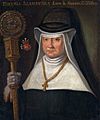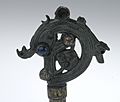Crosier facts for kids
A crozier is a special staff that looks a bit like a shepherd's crook. It's carried by important leaders in some Christian churches, like bishops and even the Pope. It's a symbol of their role as spiritual shepherds, guiding and protecting their community.
Contents
What is a Crozier?
A crozier is a tall, ceremonial staff used by bishops and other high-ranking church leaders. It often has a curved top, like a shepherd's crook, but can sometimes have a cross or other design. It's a very old symbol, showing their authority and care for the people they lead.
Who Uses a Crozier?
You'll mostly see croziers carried by bishops in the Catholic Church, Anglicanism, and some Eastern Christian churches. It's part of their special clothing when they lead important services. The Pope also has a similar staff, though it's often called a "papal ferula" and might look a bit different, sometimes with a cross instead of a crook.
What Does a Crozier Symbolize?
The crozier is full of meaning!
- Shepherd's Staff: Its shape reminds us of a shepherd's staff, showing that bishops are like shepherds guiding their flock (the people in their church).
- Authority: Carrying a crozier shows the bishop's special authority and responsibility to lead.
- Protection: Just as a shepherd uses a staff to protect sheep, the crozier symbolizes the bishop's role in protecting their community.
- Guidance: The curved top can also represent the bishop's role in gently pulling people back if they wander off, or helping them move forward.
How Are Croziers Made?
Croziers can be made from many different materials, like wood, ivory, or metal. They are often beautifully decorated with carvings, jewels, or enamel work. The designs on them can show religious scenes, symbols, or patterns. Some very old croziers are true works of art!
Images for kids
-
Pope John Paul II holding the Papal ferula, not a crosier, 5 October 1997
-
The Insular style Lismore crosier, c. 1100. National Museum of Ireland
-
Copy of the Aghadoe Crozier, Swedish History Museum, Stockholm. Originating from Aghadoe, County Kerry in the early 12th century, the crozier is formed from a single block of Walrus ivory, and contains a spiral design on the crook showing the head of an animal biting a human figure.
-
Walrus tusk, Holy Spirit as a dove, England, ca. 1120–1130, Musée national du Moyen Âge, Paris
-
Archangel Michael defeating the dragon, Limoges enamel, The Museum of Gloucester, 1220-1250
-
Ivory crosier showing the Agnus Dei, Italy, 13th century, Musée du Louvre
See also
 In Spanish: Báculo pastoral para niños
In Spanish: Báculo pastoral para niños










